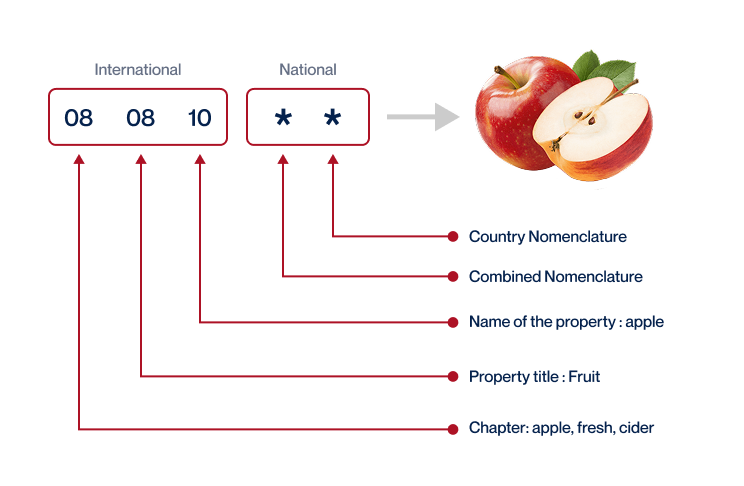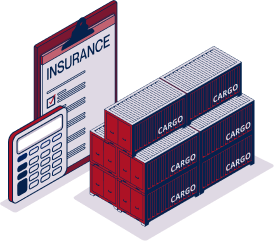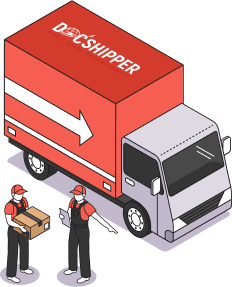Freight Shipping between Thailand and Saudi Arabia | Rates – Transit times – Duties and Taxes
Non extrait
Which are the different modes of transportation between Thailand and Saudi Arabia?
Which are the different modes of transportation between Thailand and Saudi Arabia? Embarking on the journey of shipping goods from the vibrant marketplaces of Thailand to the arid landscapes of Saudi Arabia requires an expert hand at the helm. Understanding the international borders and vast distances between these nations can feel like solving a 1,000-piece puzzle. Yet, it's clear that sea and air remain your trusty mates in this voyage. Choosing the right path isn’t just about speed, it's about aligning the method with your unique shipment needs and braving unforeseen challenges along the journey. It's not about finding the quickest route, but the smartest!
Need help with your shipment?
Need assistance with your shipment? Dont hesitate to contact us even for a simple question. Choose the option that suits you
Live chat with an expert Chat on WhatsApp Free Quote 24hHow can Siam Shipping help you

Sea freight between Thailand and Saudi Arabia
Ocean shipping forms a vital link of commerce between Thailand and Saudi Arabia, connecting key industrial hubs via bustling cargo ports like Laem Chabang and Jeddah Islamic Port. This age-old method of transport, though slow, offers a cost-effective solution for moving high volume goods across the seas.
The route, however, doesn’t come without its challenges. Businesses often grapple with the complexities of customs clearances, regulations, and shipping protocols. Missteps are common and can be costly. But fret not – like a skilled chef mastering a challenging recipe, there are best practices and specifications that can turn these intricate procedures into smooth sailing. All will be laid bare in this section, offering practical tips and insights to make your ocean-shipping journey between Thailand and Saudi Arabia as seamless as possible. Get ready to embrace your maritime adventure!
Main shipping ports in Thailand
Laem Chabang Port:
Location and Volume: Situated in the Bay of Bangkok, the Laem Chabang Port is Thailand’s primary port, and is essential for Southeast Asian trade. It has a shipping volume of more than 7.2 million TEU annually.
Key Trading Partners and Strategic Importance: Its key trading partners include China, the United States, and Japan. Serving as ASEAN’s economic gateway, it’s strategically important as it enables the Thai manufacturers to connect directly to global markets.
Context for Businesses: If you’re looking to expand trade in the ASEAN region, Laem Chabang Port offers excellent connectivity with an extensive shipping schedule and modern port infrastructure.
Port of Bangkok:
Location and Volume: The Port of Bangkok, located on the Chao Phraya River, is the second largest port in the country. It has an annual shipping volume of approximately 1.6 million TEU.
Key Trading Partners and Strategic Importance: The Port of Bangkok has a major role in Thailand’s trade with key trading partners like China, the United States, and Indo-China countries. It’s known for its specialized service in handling general cargo.
Context for Businesses: If you’re dealing with specific types of goods that can utilize the specialist handling services of the port, the Port of Bangkok could be a key part of your shipping strategy.
Songkhla Port:
Location and Volume: Located in the southern part of Thailand, Songkhla Port serves the local industries with a shipping volume of over 340,000 TEU annually.
Key Trading Partners and Strategic Importance: The port mainly serves trade with Malaysia and other ASEAN countries. It has importance for local industries, providing a direct exit to the Strait of Malacca, one of the world’s busiest shipping channels.
Context for Businesses: If Malaysia or the extension of your supply chain into southern Thailand is part of your strategy, consider shipping through the Songkhla Port.
Map Ta Phut Port:
Location and Volume: Situated in the Rayong Province, Map Ta Phut Port is one of the largest industrial ports in Thailand, handling over 19 million tonnes of cargo annually.
Main shipping ports in Thailand
Laem Chabang Port:
Location and Volume: Situated in the Bay of Bangkok, the Laem Chabang Port is Thailand’s primary port, and is essential for Southeast Asian trade. It has a shipping volume of more than 7.2 million TEU annually.
Key Trading Partners and Strategic Importance: Its key trading partners include China, the United States, and Japan. Serving as ASEAN’s economic gateway, it’s strategically important as it enables the Thai manufacturers to connect directly to global markets.
Context for Businesses: If you’re looking to expand trade in the ASEAN region, Laem Chabang Port offers excellent connectivity with an extensive shipping schedule and modern port infrastructure.
Port of Bangkok:
Location and Volume: The Port of Bangkok, located on the Chao Phraya River, is the second largest port in the country. It has an annual shipping volume of approximately 1.6 million TEU.
Key Trading Partners and Strategic Importance: The Port of Bangkok has a major role in Thailand’s trade with key trading partners like China, the United States, and Indo-China countries. It’s known for its specialized service in handling general cargo.
Context for Businesses: If you’re dealing with specific types of goods that can utilize the specialist handling services of the port, the Port of Bangkok could be a key part of your shipping strategy.
Songkhla Port:
Location and Volume: Located in the southern part of Thailand, Songkhla Port serves the local industries with a shipping volume of over 340,000 TEU annually.
Key Trading Partners and Strategic Importance: The port mainly serves trade with Malaysia and other ASEAN countries. It has importance for local industries, providing a direct exit to the Strait of Malacca, one of the world’s busiest shipping channels.
Context for Businesses: If Malaysia or the extension of your supply chain into southern Thailand is part of your strategy, consider shipping through the Songkhla Port.
Map Ta Phut Port:
Location and Volume: Situated in the Rayong Province, Map Ta Phut Port is one of the largest industrial ports in Thailand, handling over 19 million tonnes of cargo annually.
Main shipping ports in Saudi Arabia
Port of Jeddah:
Location and Volume: Positioned on the Red Sea, the Port of Jeddah is the nation’s key gateway for imports, handling nearly 59 million tons of cargo annually.
Key Trading Partners and Strategic Importance: The port’s main trading partners include India, China, the United States, and Southeast Asian countries. Its strategic geographical location has made it an essential link in the global shipping industry, acting as a connecting point for shipments between Asia, Africa, and Europe.
Context for Businesses: If you’re planning to target markets in the Middle East and North Africa regions, utilizing the Port of Jeddah could significantly streamline your shipping operations, thanks to its well-established routes and massive cargo handling capacity.
Port of Dammam:
Location and Volume: The Port of Dammam, situated on the Arabian Gulf, is the central port of the country’s Eastern Province. It handles over 24 million tons of cargo annually.
Key Trading Partners and Strategic Importance: Key trading partners include China, India, South Korea, and Singapore. Its location promotes trade with the Gulf Cooperation Council GCC countries and serves as an entry point to the Saudi market.
Context for Businesses: If your business is geared towards the fast-growing markets of the GCC, the Port of Dammam’s excellent accessibility to these economies makes it a strategic choice for your shipments.
King Fahd Industrial Port Yanbu:
Location and Volume: Based in the Red Sea region, the King Fahd Industrial Port Yanbu primarily serves the petrochemical industry, with an annual shipping volume exceeding 145 million tons.
Key Trading Partners and Strategic Importance: This port has broad international reach, but main trading partners are from Asia, Europe, and America. Specialized in the export of petroleum products, it’s been a tactical hub for the oil industry.
Context for Businesses: If your shipping needs are predominantly in the petrochemical sector, King Fahd Industrial Port Yanbu, with its specialized facilities and infrastructure, could be an integral part of your logistics plan.
Port of Rabigh:
Location and Volume: Located on the Red Sea coast, the Port of Rabigh has a shipping volume of around 20 million tons annually.
Key Trading Partners and Strategic Importance: Its main trading partners remain unspecified, but it plays a strategic role in facilitating the import and export of goods for the Rabigh Refining & Petrochemical Co.
Context for Businesses: If your enterprise is in or around the Rabigh region, the Port of Rabigh’s regional connectivity could contribute to seamless local distribution of your goods.
Port of Yanbu Commercial:
Location and Volume: Also located in the Red Sea area, the Port of Yanbu Commercial is a smaller port with around 3 million tons of cargo handled annually.
Key Trading Partners and Strategic Importance: Due to its location, it has strong trade relations with Red Sea-bordering countries. It serves a local strategic role, functioning primarily as a backup port.
Context for Businesses: If your shipping volumes are modest or you need a contingency plan to safeguard against unexpected disruption at primary ports, the Port of Yanbu Commercial offers an excellent fallback option.
King Fahd Port:
Location and Volume: The King Fahd Port, located in Dammam, is the largest port of the country in terms of shipping volume, with over 190 million tons of cargo per year.
Key Trading Partners and Strategic Importance: Like Dammam’s port, its central trading partners are Asia-Pacific countries. Its high capacity and comprehensive facilities make it a cornerstone of Saudi Arabia’s international maritime activity.
Context for Businesses: If you have high-volume shipping needs and require diverse shipping services, King Fahd Port’s impressive capacity and comprehensive modalities ensure it can comfortably handle your requirements.
Should I choose FCL or LCL when shipping between Thailand and Saudi Arabia?
Choosing between consolidation (LCL) and a full container load (FCL) can make or break your shipping journey from Thailand to Saudi Arabia. It’s a strategic choice that influences not only your pocket but also the delivery timeline and overall shipping triumph. In the following sections, you will gain clarity on each option’s ins and outs, enabling you to make an informed, customized decision. Let’s explore how these shipping terms could impact your business’s future.

Full container load (FCL)
Definition: FCL or Full Container Load shipping is a type of ocean freight where you reserve and use the entire space of either a 20'ft or 40'ft container only for your goods. When to Use: Choosing FCL shipping is often recommended when your cargo size exceeds 13/14/15 cubic meters (CBM). Its exclusivity guarantees your shipment's safety since your goods remain in the sealed container throughout the entire journey from Thailand to Saudi Arabia. Example: Imagine running a business involved in high-volume trading of Thai silk. Given the materials are bulky and sensitive to handling, getting an FCL shipping quote and booking an entire FCL container guarantees the safety and cost-effectiveness of your logistics process. Cost Implications: While FCL might appear costly upfront compared to LCL (Less than Container Load), it becomes substantially cheaper when shipping larger volumes. The cost per unit decreases significantly as the FCL container's size increases, making it a cost-effective option for heavy or bulky shipments.

Less container load (LCL)
Definition: LCL shipment, short for Less than Container Load, refers to the consolidation of multiple small shipments, possibly from different shippers, in one container. It serves as a cost-effective solution for smaller shipping volumes. When to Use: LCL freight is primarily suitable for cargo less than 13/14/15 CBM, particularly when your shipment volume isn't large enough to fill an entire container. It offers more flexibility with its price per volume metric, meeting the needs of businesses with lower volume requirements. Example: Consider a Thai toy manufacturer shipping three pallets of toys (approximately 9 CBM) to Saudi Arabia. Instead of renting a full container, they would share the space with other shippers in the same container, cutting down on costs considerably, while not needing to wait until they have enough cargo to fill the whole container. Cost Implications: With LCL, you pay only for the container space you utilize. However, keep in mind that there may be additional charges at the destination port as the cargo needs to be deconsolidated. With such considerations, an LCL freight quote may often provide cheaper and more manageable shipping, particularly for smaller scaled shipments.
Hassle-free shipping
Translating the complexities of cargo shipping into simple solutions, DocShipper's expertise helps businesses make informed decisions. Whether to opt for consolidation or full container syncs perfectly with your logistic needs, is dictated by factors such as cargo volume, budget, and speed. Our ocean freight specialists are ready to assist, encouraging you to explore the most optimal route between Thailand and Saudi Arabia. Ready to make shipping a breeze? Get in touch for a free estimate!
How long does sea freight take between Thailand and Saudi Arabia?
Sea freight from Thailand to Saudi Arabia typically takes around 29 days, although this timeframe may vary. The exact transit duration hinges on a number of important factors, such as the specific port of origin and destination, the weight, and nature of the goods being shipped. To ensure the most accurate information, it’s wise to seek a custom quote from a trusted freight forwarder like DocShipper.
To give you a rough understanding, here’s a rudimentary table illustrating the average transit times between key ports in these two countries:
Origin (Thailand) Destination (Saudi Arabia) Average Transit Time (days) Port of Laem Chabang Port of Jeddah 34 Port of Bangkok Port of Dammam 31 Port of Songkhla Port of Jeddah 18 Port of Bangkok Port of Yanbu 34*These values denote industry averages and may change. Speak to a freight forwarder to get timeframes tailored to your specific shipment.
How much does it cost to ship a container between Thailand and Saudi Arabia?
Costs for shipping a container from Thailand to Saudi Arabia vary remarkably and can range from a few hundred to thousands of dollars per CBM. These ocean freight rates are influenced by several significant factors, including the Point of Loading, Point of Destination, the carrier chosen, nature of goods, and market fluctuations. Pinning down an exact shipping cost isn’t plausible due to these dynamic elements. However, don’t fret! Our team of shipping specialists is here to help navigate these waves. Be assured, we analyze each shipment individually to secure the optimum prices tailored to your unique logistics requirements.
Special transportation services
Out of Gauge (OOG) Container
Definition: An OOG container, or Out of Gauge container, is a specialized container that accommodates cargo which does not fit within standard shipping container dimensions, due to its size or weight. Suitable for: Irregularly sized or shaped items, overweight goods, large machinery components and equipment. Examples: Construction materials, industrial equipment, windmill propellers, yachts. Why it might be the best choice for you: If your goods exceed standard container dimensions, Out of gauge cargo shipping is a flexible option that ensures secure transportation of your large or heavy goods from Thailand to Saudi Arabia.
Break Bulk
Definition: Break Bulk shipping involves separately loading each item onto the vessel. It’s often used for large, heavy, or awkwardly shaped goods that can’t fit into typical containers. Suitable for: Large equipment or infrastructure parts, heavy machinery. Examples: Power plant equipment, turbines, excavators, cranes. Why it might be the best choice for you: If you have oversized or particularly heavy items, break bulk shipping is an excellent way to handle your loose cargo load, providing custom freight solutions for complex shipments.
Dry Bulk
Definition: Dry Bulk shipping is used when cargo, like commodities, are loaded on board in large quantities without any packaging. Suitable for: Granular materials, coal, grains, sand, minerals. Examples: Cereals, gravel, coal, iron ore. Why it might be the best choice for you: If you’re mainly dealing with unpackaged, free-flowing dry commodities, dry bulk shipping could provide a practical, efficient mode of transportation.
Roll-on/Roll-off (Ro-Ro)
Definition: Roll-on/Roll-off, or Ro-Ro is a type of shipping where vehicles and machinery are driven on and off a specialized Ro-Ro vessel on their own wheels. Suitable for: Cars, trucks, tractors, buses, construction and farming equipment. Examples: Motorbikes, trailers, caravans or agricultural tractors. Why it might be the best choice for you: If your freight includes self-propelled or towable machinery and vehicles, Ro-Ro could be your best bet, with minimal handling of the cargo ensuring less risk of damage.
Reefer Containers
Definition: Reefer containers are temperature-controlled containers used to transport perishable goods that need a consistent climate. Suitable for: Fresh or frozen food and beverages, pharmaceuticals, flowers Examples: Meat, dairy, fruits, vegetables, vaccines. Why it might be the best choice for you: If your business trades in products that require regulated temperature conditions, refrigerated containers can ensure your goods arrive in Saudi Arabia in the same condition they left Thailand.
Understanding your shipping options is the first step to making the best decision for your specific needs. At DocShipper, we’re here to guide you through that process. For a free shipping quote in less than 24hrs, we invite you to get in touch with us right away.

Air freight between Thailand and Saudi Arabia
Air freight between Thailand and Saudi Arabia is like running your global business on a Formula1 track – it’s fast, reliable, and excellent when you’re dealing with small, valuable items. Imagine air freight as a courier service for your brand-new smart-phones, fine Thai silk, or essential medical supplies. Now, on the flip side, many shippers stumble by overlooking critical factors when opting for air freight. It’s like going into a football match without knowing the offside rule. The penalty? Costly mistakes – misjudging the pricey weight formula, for instance. Inadequate know-how could make your shipping budget skyrocket beyond those clouds you’re flying over. Up next, we’ll delve into avoiding these common pitfalls – because no one likes a surprise hit to their bottom line.
Air Cargo vs Express Air Freight: How should I ship?
Looking to ship goods from Thailand to Saudi Arabia swiftly? Air Cargo, which rides along with passenger airlines, can help, but if time is of the essence, Express Air Freight’s dedicated planes may be the right choice. Let’s unlock the difference between these two options to streamline your business logistics and help you make an informed shipping decision.
Should I choose Air Cargo between Thailand and Saudi Arabia?
Opting for air cargo between Thailand and Saudi Arabia can be an economically sound and reliable choice. Airlines such as Saudi Arabian Airlines and Thai Airways are significant players, with regular and reliable freight services. Air cargo becomes price competitive, particularly when shipping weights exceed 100/150 kg (220/330 lbs). However, longer transit times can occur due to rigid airline schedules. If budget is your foremost concern, which we understand for many businesses, air cargo can often meet your needs. It is essential to compare and consider other freight options too, to select the best fit for your specific shipment.

Should I choose Express Air Freight between Thailand and Saudi Arabia?
Looking to expedite your shipping from Thailand to Saudi Arabia? Express Air Freight, offered by courier giants like FedEx, UPS, or DHL, could serve you best. As a specialized service using cargo-only planes for rapid delivery, it’s ideal for shipments under 1 CBM or 100/150kg (220/330 lbs). This way, your shipment is delivered fast without wasting space or cost. Think of it as your personal air bridge between Thailand and Saudi Arabia, enabling smooth and quick trade. Now, allocating resources and meeting tight deadlines might just become a tad less worrying for your business.

Main international airports in Thailand
Suvarnabhumi Airport
Cargo Volume: Suvarnabhumi Airport handled around 1.3 million tons of cargo annually , making it the busiest cargo airport in Thailand. Key Trading Partners: Key trading partners include China, Japan, and the United States, having strong connections with major economic centres worldwide. Strategic Importance: As Bangkok’s main gateway, Suvarnabhumi Airport is strategically located within reach of dynamic Southeast Asian markets. Notable Features: The airport boasts state-of-the-art facilities, including modern cargo terminal buildings and a dedicated Free Zone for cargo processes. For Your Business: If your business relies heavily on speed and efficiency, Suvarnabhumi Airport’s robust cargo handling facilities and wide range of international connections could significantly streamline your supply chain.
Don Mueang International Airport
Cargo Volume: While primarily serving domestic routes, Don Mueang International Airport still comfortably handled over 18,000 tons of international cargo in 2019. Key Trading Partners: The airport maintains cargo partnerships mainly within Asia, including China, India, and several ASEAN countries. Strategic Importance: As Thailand’s second busiest airport, Don Mueang supports overflow from Suvarnabhumi, offering additional flexibility for cargo transit in Southeast Asia. Notable Features: It is home to a number of budget airlines, which provides competitive freight forwarding services. For Your Business: If your business aims to save on shipping costs, especially within Asia, the presence of budget airlines at Don Mueang could make it an attractive option.
Phuket International Airport
Cargo Volume: Despite being known as a tourist hub, Phuket International Airport handled close to 10,000 tons of cargo in 2019. Key Trading Partners: Key cargo routes connect Phuket with China, Russia, India, and the Middle East. Strategic Importance: Located in the South, this airport forms a crucial link to tap into emerging markets in the Indian Subcontinent, Middle East, and the broader Asian region. Notable Features: The airport is well-equipped to handle temperature-sensitive cargo – a boon for industries like pharmaceuticals and perishables. For Your Business: If your business involves temperature-sensitive goods, Phuket International’s specialized facilities can ensure your cargo maintains its integrity during transit.
Chiang Mai International Airport
Cargo Volume: Chiang Mai International Airport handled approximately 5,700 tons of cargo in 2019. Key Trading Partners: The airport serves several Asian nations, including China, Singapore, and Malaysia. Strategic Importance: As the main airport for Northern Thailand, Chiang Mai International allows businesses to bypass busier Southern airports when servicing Asian markets. Notable Features: The airport boasts dedicated cargo space and hosts flights from a variety of both full-service and budget carriers. For Your Business: The airport’s dedicated cargo services, coupled with its location, can offer your business quick access to key markets in Asia, avoiding potentially congested southern routes.
U-Tapao Rayong Pattaya International Airport
Cargo Volume: Though smaller in size, U-Tapao Rayong Pattaya International Airport is looking to expand its cargo capability. Key Trading Partners: The airport is gradually broadening its connections but its main cargo partners remain within Asia. Strategic Importance: Located in the Eastern Economic Corridor, this airport is perfectly positioned to take advantage of the Government’s push to develop the region. Notable Features: It has a modern air cargo center and houses the Thai Airways Technical Department which provides maintenance services. For Your Business: If you’re seeking to tap into the potential of the burgeoning Eastern Economic Corridor, U-Tapao Rayong Pattaya offers a prime route into this rapidly developing region.
Main international airports in Saudi Arabia
King Khalid International Airport
Cargo Volume: King Khalid International Airport handled approximately 800,000 metric tons of cargo in 2020, making it a significant hub in the region.
Key Trading Partners: The main trading partners of Saudi Arabia through this airport are the United Arab Emirates, China, and India.
Strategic Importance: Its strategic location to the north of Riyadh gives businesses access to the heart of Saudi Arabia and the wider Middle East.
Notable Features: The airport boasts four operational terminals with cargo facilities, including cool and cold store facilities suitable for perishable goods.
For Your Business: If you’re shipping perishable items or need quick access to the central regions of Saudi Arabia, King Khalid International offers the facilities and location to speed up your business’s logistics.
King Abdulaziz International Airport
Cargo Volume: Handling around 700,000 metric tons of cargo in 2020, King Abdulaziz International Airport is a significant player in Saudi Arabia’s air freight industry.
Key Trading Partners: The United States, China, and India are its primary trading partners.
Strategic Importance: Located in Jeddah, it serves as a major gateway to the holy city of Mecca.
Notable Features: Two cargo villages provide state-of-the-art facilities for handling a variety of goods, while its dedicated cargo terminal is one of the most modern in the world.
For Your Business: The airport’s proximity to Mecca makes it strategically important if you ship goods linked to the Hajj and Umrah pilgrimages, while its modern facilities ensure your cargo is handled securely and efficiently.
King Fahd International Airport
Cargo Volume: In 2020, King Fahd International handled over 500,000 metric tons of cargo.
Key Trading Partners: Key trading partners include China, the United States, and the United Arab Emirates.
Strategic Importance: As the third busiest airport in the kingdom and the main air gateway for Saudi Arabia’s Eastern Province, this airport offers route coverage across the Persian Gulf and Asia.
Notable Features: The airport’s cargo village covers 40,000 square meters with an annual handling capacity of over 94,000 tons.
For Your Business: Given its strategic location and access to Asian markets, choosing King Fahd International as a shipping point can facilitate quicker access to these markets, driving efficiencies in your distribution.
Prince Mohammad bin Abdulaziz International Airport
Cargo Volume: This airport handled approximately 30,000 metric tons of cargo in 2020.
Key Trading Partners: Key trading partners comprise the UAE, Turkey, and India.
Strategic Importance: The airport serves the Al Madinah Province in the western part of Saudi Arabia, offering a vital role in transportation during the Hajj and Umrah seasons.
Notable Features: The cargo terminal is equipped with modern facilities and a comprehensive security system.
For Your Business: The airport’s unique position during the Hajj and Umrah seasons could provide your business with an opportunity to reach a distinct customer base quickly and securely.
Abha International Airport
Cargo Volume: Abha Airport handled around 15,000 metric tons of cargo in 2020.
Key Trading Partners: Its primary trade partners include the UAE and neighboring GCC countries.
Strategic Importance: Located in the Asir Province of Saudi Arabia, Abha Airport allows access to Southern Saudi Arabia and Yemen.
Notable Features: It features one main cargo terminal, which offers cool and cold storage facilities for perishable goods.
For Your Business: It would be an excellent choice if your business involves shipping perishable goods or if you’re looking to access the southern regions of Saudi Arabia and Yemen.
How long does air freight take between Thailand and Saudi Arabia?
On average, air freight shipping from Thailand to Saudi Arabia takes approximately 3-5 days. However, do bear in mind that these transit times are not absolute. Factors such as the specific airports of origin and destination, the weight and dimensions of the shipment, and the nature of the goods can all influence these timelines. It’s important to consult a freight forwarding specialist like DocShipper to obtain precise timing based on your particular requirements.
How much does it cost to ship a parcel between Thailand and Saudi Arabia with air freight?
Shipping air freight from Thailand to Saudi Arabia usually falls within a rate range of $2.5 – $6.5 per kg. Providing an exact price is complex due to several influencing factors, including distance from the originating and destination airports, package size and weight, and the nature of the goods. However, you can trust our experienced team to work with you, providing the most suitable and competitive rates tailored to your specific requirements. Each quote is uniquely calculated, ensuring you only pay for what you truly need. Contact us and receive a free quote in under 24 hours.
What is the difference between volumetric and gross weight?
Understanding volumetric and gross weight is key in air freight shipping. Gross weight refers to the total weight of your shipment, including packaging or pallet. On the other hand, volumetric weight, sometimes known as dimensional weight, takes into account the space your cargo occupies in an aircraft.
For Air Cargo, gross weight is straightforward, just weighing the total shipment. Volumetric weight, however, is calculated differently. It’s determined by multiplying the length, width, and height of your package in centimeters, and then dividing this by 6,000. This gives you the volumetric weight in kilograms.
Take for instance you have a package of dimensions 100cm x 100cm x 100cm. The volumetric weight would be (100 x 100 x 100) / 6,000, equalling 166.67 kg (or about 367.44 lbs).
On the other hand, Express Air Freight services differ slightly, calculating the volumetric weight by diving by 5,000 instead of 6,000. So our hypothetical 100cm x 100cm x 100cm package would have a volumetric weight of 200 kg (or around 440.92 lbs).
These calculations are key because they determine your shipping costs. Freight charges are based on either the gross weight or volumetric weight – whichever is higher. This ensures carriers maximize their profitability, by considering both the weight and space of cargo.
So, it’s of great importance you calculate both weights to avoid any unwelcome surprises when shipping goods from Thailand to Saudi Arabia.

Door to door between Thailand and Saudi Arabia
Door to Door shipping is an ultimate convenience in international logistics, ensuring goods are collected and delivered right from your doorstep in Thailand to its destination in Saudi Arabia. You save on time, stress, and enjoy simplified customs procedures. Intrigued? Well, sit tight as we unravel the perks of this ace service. So without further ado, let’s dive in!
Overview – Door to Door
Worried about the complexities of shipping between Thailand and Saudi Arabia? Choosing door to door shipping might dissolve those woes. This stress-free solution manages the entire logistics process, minimizing headaches from transport to customs clearance. Yet, it might be more costly and take longer. With DocShipper’s clients often favoring this service for its convenience, it’s clear this might be the most feasible solution despite the possible drawbacks. Go ahead, simplify your logistics – door to door shipping is here to help.
Why should I use a Door to Door service between Thailand and Saudi Arabia?
Think of sending a parcel as sending your pet elephant on vacation. — that’s the fun part. But the reality of logistics often involves more juggling than a circus performer! Here are five reasons why Door to Door service between Thailand and Saudi Arabia saves the day:
1. Bye-Bye, Stress: Coordinating partners, organizing paperwork, tracking consignments — things can get hairy fast! With Door to Door service, the freight forwarder eliminates this circus in one simple swoop.
2. Timely Tidings: Ever had that low-sinking feeling when an urgent shipment is delayed? Us too, and it’s not fun. That’s why Door to Door service focuses on firm delivery schedules, reducing hiccups in transit and ensuring your elephant… ahem, cargo… arrives on time!
3. Specialized Care: Maybe your cargo isn’t an elephant but it’s something equally as tricky to navigate? Fret not! Door to Door service thrives on complex challenges, providing dedicated care to ensure even the most unique shipments reach their new stomping grounds safe and sound.
4. Convenience Central: Door to Door service is just that — pick-up from your doorstep and delivery to the destined doorstep. No need to bother about trucking or handling, it’s all part of the package.
5. No Hidden Surprises: When it comes to cost, no one likes a nasty surprise. The great thing about Door to Door service is its simplicity: one cost covers everything. Now that’s something worth tooting your elephant’s trunk about!
So put away the circus gear, sit back, relax and let Door to Door do the heavy lifting.
DocShipper – Door to Door specialist between Thailand and Saudi Arabia
Experience stress-free, door-to-door shipping between Thailand and Saudi Arabia with DocShipper. Trust our expertise in comprehensive freight forwarding services, from packing and transport to customs clearance across all shipping methods. With us, there’s no need to worry, as we handle every detail. What’s more? You are matched with a dedicated Account Executive to cater to all your logistics needs. Reach out for a free estimate within 24 hours or talk to our expert consultants at no cost. We are here to simplify your global shipping process.

Customs clearance in Saudi Arabia for goods imported from Thailand
Customs clearance is the procedure by which international goods are legally imported into a country, in this case, Saudi Arabia from Thailand. It’s a complex process requiring a solid understanding of the duties, taxes, quotas, and licenses affecting trade between the two countries. Unexpected fees and delayed goods are common pitfalls if not managed right. Our forthcoming sections will dissect these areas clearly. Assuredly, DocShipper is at your service globally. Our team takes care of the whole customs clearance process regardless of the type and origin of goods. Should you want an estimate to budget your project, don’t hesitate to hit us up. Just provide the origin of your goods, their value, and the HS Code. Armed with these, we can proceed with your estimate.
How to calculate duties & taxes when importing from Thailand to Saudi Arabia?
Understanding the estimation of duties and taxes is critical when embarking on the journey of importing goods from Thailand to Saudi Arabia. This integral step involves a few crucial components such as the origin country of the goods, the Harmonized System (HS) Code of the items, the customs value, along with the applicable tariff rate, and any other additional charges, taxes, and fees associated with the imported products. Identifying the country where your items have been manufactured or produced constitutes the initial stepping-stone in this process. Let’s break this down further aided by some real-world examples to make this concept easily digestible for you.
Step 1 – Identify the Country of Origin
Determining the country of origin comes first for five key reasons:
1. Trade Agreements: Thailand and Saudi Arabia have mutual trade agreements impacting customs duties. Knowing your goods’ origin supports these, often lowering costs. 2. Tariff Rates: Variations exist based on origin. Verifying origin helps ascertain accurate tariff rates. 3. Export Restrictions: Likewise, import restrictions exist. Some goods need certain certifications or are entirely banned, based on origin. 4. Documentation: The source country dictates essential paperwork. Ensure legal, hassle-free shipment. 5. Customs Expectations: Clear up customs quickly and successfully, mitigating unexpected hold-ups.
Thailand enjoys preferential trade agreements with Saudi Arabia. Specific Thai products receive lower or even zero tariffs due to these agreements. So, your goods’ origin significantly impacts the duties paid. As a business, knowing such agreements equips you with financial foresight.
Import restrictions also abound, varying by product category and origin. Your goods might require special permissions, or face total import bans. So, research these carefully to avoid mishaps.
Make this first step count. Get acquainted with your product’s origin, the existing agreements, and possible restrictions. This sets the foundation for a smooth overseas shipment.
Step 2 – Find the HS Code of your product
The Harmonized System (HS) Code is a standardized numerical method of classifying traded products. It allows customs authorities to precisely identify what’s being imported or exported, thus determining the taxes, duties, and regulations that apply.
Usually, the most straightforward course of action is to obtain the HS code from your supplier, as they’re likely already familiar with the products they’re exporting and the relevant customs regulations.
However, if that’s not an option, we’re here to help you find the HS Code yourself through an easy 3-step process:
1. Go to the Harmonized Tariff Schedule 2. Enter the product name in the search bar. 3. Look at the ‘Heading/Subheading’ column, which contains the HS code.
Please take note that accuracy is incredibly important when choosing the HS Code. An incorrect code can lead to delays in shipping or even potential fines. It’s vital to make sure you have the right one.
Here’s an infographic showing you how to read an HS code.

Step 3 – Calculate the Customs Value
Cracking the customs code starts with understanding Customs Value. If you thought it’s just the actual cost of your goods from Thailand, you’re not alone. However, it’s a bit more nuanced. Customs Value is actually your CIF value – the trifecta of Cost of goods, Insurance, and Freight. The Cost is what you paid for your items. Insurance is what you shell out to protect your goods en route. Freight – that’s the cost you bear for transporting your goods from Thailand to Saudi Arabia. Let’s say you bought goods worth $1000, paid $200 for shipping, and a $50 insurance premium. Your Customs Value isn’t the $1000 you initially thought. It’s actually $1250. Understanding this critical detail can save you from any unexpected customs obligations down the line. So give careful attention to your CIF when calculating your Customs Value.
Step 4 – Figure out the applicable Import Tariff
Import tariffs, simply put, are taxes on imported goods. The purpose is to protect domestic businesses and jobs from foreign competition. Saudi Arabia uses the Harmonized System(HS), which is a globally recognized classification system for trades.
To identify the import tariff, you’ll need the HS code for the product you’re exporting. As an example, let’s take a hypothetical shipment of washing machines from Thailand to Saudi Arabia, with the HS code 845011. You would input this into a tariff lookup tool available via Saudi’s official Saudi Customs Website. Follow these steps:
1. Enter the HS code that was identified earlier and the country of origin (Thailand). 2. Check the duties and taxes applied to your product.
To better illustrate this, suppose that the CIF cost (the cost of the goods plus insurance and freight) is $10,000 and the tool specifies a tariff rate of 5%. The calculation of the import duty would be: $10,000 × 5% = $500.
Remember, having the correct information including accurate HS codes will help you avoid unexpected costs and delays.
Step 5 – Consider other Import Duties and Taxes
In addition to standard tariff rates, other import duties may come into play when importing goods from Thailand to Saudi Arabia, highly influenced by the origin country and product type. For instance, excise duty is applied on specific products like carbonated drinks at 50%.
Surprises can also come in form of anti-dumping taxes, levied on goods sold substantially below their normal value. Consider if you import a Thai air conditioner worth $200 – an anti-dumping tax might increase your costs unexpectedly.
On top of these, VAT is critical. In Saudi Arabia, it’s currently 15% on the customs value. So for a $1,000 machine, besides any customs duty and so forth, there’s an extra $150 VAT. Remember, these are merely illustrations, rates can vary.
Understanding these nuances helps avoid unexpected costs, keeping your budget in check. It’s always beneficial to consult a customs broker, or professional service like ours, to get accurate, updated information.
Step 6 – Calculate the Customs Duties
At this stage, it’s crucial to nail down the exact costs of your shipment from Thailand to Saudi Arabia. The customs duty calculation revolves around three key elements: the customs value, VAT, and potential anti-dumping taxes and Excise Duty.
The formula is straightforward: Customs Duty = customs value customs tariff. In a scenario with only customs duties and no VAT, imagine a customs value of $10,000 with a 5% customs tariff. Your duty would thus be $500.
If VAT gets involved, it adds an extra layer. VAT is applied not just to the customs value but also to the duty itself. So in our previous example, if Saudi Arabia’s 15% VAT is imposed, you would owe $1,575: the original $500 plus 15% of $10,500 ($1,075).
In some cases, extra taxes such as anti-dumping taxes and Excise Duty can apply. For a product that incurs a 10% anti-dumping tax and 5% Excise Duty on a $10,000 customs value, your overall cost would be the custom duty ($500) + VAT on ($10,500) + Anti-Dumping ($1,000) + Excise Duty ($500) = $3,075.
The customs clearance process can be tough to navigate alone, but there’s no need to fret. DocShipper’s skilled team can take care of every step in any corner of the globe. Contact us for a free quote within 24 hours. With us at your side, you can avoid paying more than necessary.
Does DocShipper charge customs fees?
Let’s clear up a common mix-up: DocShipper, as a customs broker in Thailand and Saudi Arabia, isn’t the entity charging you customs duties. Our clearance fees are separate, covering our role in navigating customs for you. Duties and taxes? Those go straight to the government. Operating in transparency, the documents from customs proving this will be in your hands, so you’ll see you’re only funding the actual customs charges. It’s like when you pay a concierge fee for services at a hotel, separate from the hotel room’s cost. Simple, right?
Contact Details for Customs Authorities
Thailand Customs

Official name: Customs Department Kingdom of Thailand. Official website: http://www.customs.go.th/
Saudi Arabia Customs

Official name: Saudi Customs Authority Official website: https://www.customs.gov.sa/
Required documents for customs clearance
Mastering customs paperwork can be a headache, right? Let’s simplify things. In our guide, we’ll decipher key documents for smooth clearance: Bill of Lading, Packing List, Certificate of Origin, and Documents of Conformity (CE standard). It’s time to tackle customs like a pro!
Bill of Lading
Navigating the waters of international shipping between Thailand and Saudi Arabia? You’ll require a Bill of Lading for sea transport. This critical document stands as a symbol of ownership transfer and determines who takes custody of your goods at arrival. There’s also an option to consider: telex or electronic release. It’s ideal for shippers craving speed, as it enables fast access to documents – a necessity in our digital era. For the lot that opts for air cargo, there’s the AWB or Air Waybill, a like-for-like document for air shipping. Just remember, always double-check your Bill of Lading or AWB details as even tiny errors can complicate the customs clearance process. Be accurate, be smart, and watch your goods flow smoothly from Thailand to Saudi Arabia.
Packing List
In shipping goods from Thailand to Saudi Arabia, your Packing List acts as the hero document that makes clearing customs a breeze. Think of this list as the blueprint of your shipment, detailing every item in your freight, their quantities, and descriptions. Whether you’re using sea or air routes, Saudi customs officials will scrutinize this list to verify the contents of your shipment.
For instance, let’s say your business specializes in Thai Silk. A well-detailed packing list breaks down the quantity of silk in each box, field, or unit in your shipment. Skimping on this important detail could lead to customs bottlenecks, unnecessary charges, or worse, seizure of your shipments.
Remember, details matter, and accuracy is paramount. So, if you don’t want your Thai Silk stuck in a customs warehouse, invest time in perfecting your Packing List. This simple, yet essential step could save you time, cost, and the hassle of untangling a web of customs issues.
Commercial Invoice
When you’re shipping goods from Thailand to Saudi Arabia, your Commercial Invoice is a key player. It needs to have specific details like item description, quantity, value, and HS codes. This document serves as a declaration to Saudi customs about what you’re sending and its worth. Misalignment between your Invoice and other shipping documents can trigger delays and extra charges, so it’s vital to stay consistent. A tip to overcome this challenge is to double-check your declarations match across all documents. For instance, if you’re exporting 500 pairs of leather shoes priced at $50 each, this exact information should reflect in every shipping document. Avoid general terms like footwear. Instead, be precise: Leather shoes, size 40. Remember, the Commercial Invoice is your first line of communication with Saudi customs; make it count.
Certificate of Origin
When shipping goods between Thailand and Saudi Arabia, don’t overlook the Certificate of Origin. This document confirms the country where your cargo was manufactured. An accurate Certificate not only ensures smooth customs clearance but might also qualify your shipment for preferential customs duty rates, giving you a potential edge on costs. For example, a Thai electronics manufacturer shipping its products to Saudi Arabia would need to clearly state ‘Made in Thailand’ on the certificate. So, before shipping, double-check your Certificate of Origin. It’s not just a formality. It’s a valuable tool to optimize your shipment and manage your expenses.
Get Started with Siam Shipping
Prohibited and Restricted items when importing into Saudi Arabia
Understanding the ins and outs of what you can/can’t ship to Saudi Arabia can feel like a minefield. It’s crucial to stay in the loop about prohibited and restricted goods to prevent headaches down the line.
Are there any trade agreements between Thailand and Saudi Arabia
Yes, Thailand and Saudi Arabia share beneficial trade relationships but don’t currently have Free Trade Agreements (FTAs) or Economic Partnership Agreements (EPAs). However, talks are underway to expand trade links, so keep an eye out for any opportunities this could bring to your business. Infrastructure developments like the proposed ‘Asia-Africa Growth Corridor’ could also create new avenues for your trade routes. Understanding these factors gives your business an edge in navigating the shipping landscape between these two countries.
Thailand – Saudi Arabia trade and economic relationship
Trade ties between Thailand and Saudi Arabia, rich in history, have pivoted on major commodities like rice, rubber, and seafood from Thailand and oil from Saudi Arabia. Over time, the relationship diversified into sectors like construction, healthcare, and education. Currently, Saudi Arabia ranks as Thailand’s second-largest market in the Middle East. Appreciable trade figures saw exports from Thailand to Saudi Arabia reach $1.2 billion in 2020. Simultaneously, imports accounted for $2.7 billion, with oil accounting for over 55% of these Saudi exports. This balance has carved a path for solid future business growth.
Your first steps with Siam Shipping
Additional logistics services
Warehousing
Finding the right warehouse in Thailand or Saudi Arabia can feel like a Herculean task. You want peace of mind, knowing your goods are safe - temperature control, for example, is non-negotiable for perishable items. Break free from this stress. Discover world-class, trustworthy storage solutions tailored to your unique needs. Get all the juicy details on our dedicated page: Warehousing.
Packing
Ensuring your goods reach Saudi Arabia from Thailand in pristine condition calls for robust packaging and repackaging. Trust in our experienced agents who can cater to a wide range of products—from fragile glassware to heavy machinery. For instance, we use bespoke crating for bulky goods, ensuring safe transit even on rough sea routes. More info on our dedicated page : Freight packaging.

Transport Insurance
Insurance in shipping acts as your safety net, much more versatile than just fire coverage. It safeguards your cargo from any potential hazards during the voyage. Think rough seas damaging packaging or unexpected delays causing spoilage. With Cargo Insurance, such risks become less intimidating, letting you breathe easier. Dive deeper into this essential service on our Cargo Insurance page.

Household goods shipping
Understanding that moving between Thailand and Saudi Arabia isn't easy, especially if you're dealing with bulky or delicate items, we're here to provide unbeatable safety and flexibility. Whether it's a decade-old vintage clock or a state-of-the-art home theater, we handle your treasures with professional rigor. Experience a worry-free move with our Personal Effects Shipping Service. More info on our dedicated page: Shipping Personal Belongings

Procurement in Thailand
Securing reliable suppliers can be tough, especially across different languages and cultures. DocShipper simplifies this by seeking and vetting top-tier suppliers from Asia, East Europe and beyond. Bid farewell to linguistic or process confusion as we guide you every step of the way, making your global procurement seamless and void of hiccups. More info on our dedicated page: Sourcing services

Quality Control
Ensuring your products from Thailand meet Saudi Arabian standards is crucial. Picture quality inspections catching that batch of defective toys before shipping, averting customer dissatisfaction and potential legal issues. Our Quality Control service saves you from costly recalls or re-shipments. Explore how we safeguard your brand and bottom line on our dedicated page: Quality Inspection.

Conformité des produits aux normes
Avoid shipping roadblocks with our Product Compliance Services. Ensuring your goods meet destination regulations can save you time and hassle. Get peace of mind with our lab tests and certification process, verifying your product's compliance. Keep your shipment smooth and avoid untoward delays or rejected entries. More insights are just a click away on our dedicated page: Product compliance services.





